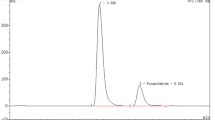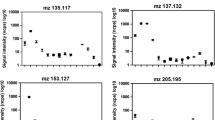Abstract
Several standardized methods exist to determine formaldehyde (HCHO) release from wood-based panels (WBPs). These methods were developed decades ago to be used in manufacturers laboratories to provide a mean of production control. They are robust and take several hours to yield results. Modern WBP panel production, however, is a continuous process. Therefore the established methods are too time-consuming for process control and process optimization with respect to HCHO release. Moreover, there is a strong trend of lowering the regulatory HCHO emission limits. Thus, there is a need for a comparatively fast and precise method which is suitable for the use on-site in a WBP manufacturers laboratory. In this work, an optimization of the solid phase micro extraction gas chromatography high field asymmetric waveform ion mobility spectrometry (SPME-GC-FAIMS) method is presented with respect to GC-FAIMS settings and the calibration procedure. It is also shown that, in addition to WBP block samples, also particles can be used for the measurement. The industrial applicability of SPME-GC-FAIMS system was demonstrated by testing the HCHO release of freshly produced WBPs on-site in the manufacturers laboratory.









Similar content being viewed by others
References
Andre N, Young TM, Rials TG (2009) Spectroscopic prediction of formaldehyde emission and thickness swell of wood panel. Patent. US 2009/0230306 A1, USA
Anonymus (1989) Indoor air quality - Report on an WHO meeting. EURO Reports and Studies. World Health Organization - Regional Office for Europe, Kopenhagen. p. 70
ATCM (2008) §93120 AIRBORNE TOXIC CONTROL MEASURE to reduce formaldehyde emissions from composite wood products [17 Cal. Code Regs. sections 93120–93120.12]. California Environmental Protection Agency Air Resources Board, Sacramento
ChemVerbots V (2003) Verordnung über Verbote und Beschränkungen des Inverkehrbringens gefährlicher Stoffe, Zubereitungen und Erzeugnisse nach dem Chemikaliengesetz. Chemikalien-Verbotsverordnung in der Fassung der Bekanntmachung vom 13. Juni 2003 (BGBl. I S. 867), die zuletzt durch Artikel 5 Absatz 40 des Gesetzes vom 24. Februar 2012 (BGBl. I S. 212) geändert worden ist
Dunky M (1999) in Dunky M, Niemz P (2002) Holzwerkstoffe und Leime: Technologie und Einflussfaktoren. Springer Verlag, Berlin Heidelberg New York
Eiceman GA, Tarassov A, Funk PA, Hughs SE, Nazarov EG, Miller RA (2003) Discrimination of combustion fuel sources using gas chromatography-planar field asymmetric-waveform ion mobility spectrometry. J Sep Sci 26(6–7):585–593
EN 120 (1992) Wood-based panels; Determination of formaldehyde content; Extraction method called the perforator method. European Committee for Standardisation, Brussels, Belgium
EN 13986 (2005) Wood-based panels for use in construction-Characteristics, evaluation of conformity and marking. European Committee for Standardisation, Brussels, Belgium
EN 312 (2010) Wood-based panels; Particleboards - Specifications. European Committee for Standardisation, Brussels, Belgium
EN 717–1 (2004) Wood-based panels - Determination of formaldehyde release - Part 1: Formaldehyde emission by the chamber method. European Committee for Standardisation, Brussels, Belgium
EN 717–2 (1994) Wood-based panels - Determination of formaldehyde release - Part 2: Formaldehyde release by the gas analysis method. European Committee for Standardisation, Brussels, Belgium
Engström B (2008) Evaluation of formaldehyde emission from low emission composite board. Paper presented at the 3.Fachtagung Holztechologie, Göttingen, Germany
Engström B, Hedqvist M (1999) Prediction of the properties of board by using a spectroscopic method combined with multivariate calibration. Patent, US005965888A, USA
Hasener J (2011) Formaldehyd-Gasanalyse nach EN 717–2. Holz Zentralblatt 6:170
JIS A 5908 (2003) Particleboards; Japanese Industrial Standard. Japanese Industrial Standards Committee, Tokyo, Japan
Kim S (2010) Control of formaldehyde and TVOC emission from wood-based flooring composites at various manufacturing processes by surface finishing. J Hazard Mater 176(1–3):14–19
Lawrence AH, Barbour RJ, Sutcliffe R (1991) Identification of wood species by ion mobility spectrometry. Anal Chem 63(13):1217–1221
Leonhardt JW, Rohrbeck W, Bensch H (2000) A high resolution IMS for environmental studies. Int J Ion Mobil Spectrom 3(1):43–49
Limero T, Reese E, Cheng P, Trowbridge J (2011) Preparation of a gas chromatograph-differential mobility spectrometer to measure target volatile organic compounds on the international space station. Int J Ion Mobil Spectrom 14(2–3):81–91
Mantau U (2012) Standorte der Holzwirtschaft, Holzrohstoffmonitoring, Holzwerkstoffindustrie-Kapazitätsentwicklung und Holzrohstoffnutzung im Jahr 2010. Universität Hamburg, Zentrum Holzwirtschaft. Arbeitsbereich Ökonomie der Holz- und Forstwirtschaft. Hamburg
Martos PA, Pawliszyn J (1998) Sampling and determination of formaldehyde using solid-phase microextraction with on-fiber derivatization. Anal Chem 70(11):2311–2320
Marutzky R (1989) Possibility of diminishing the indoors formaldehyde content. Holz Roh Werkst 47(5):207–211
Marutzky R, Flentge A, Boehme C (1992) Formaldehyde emission of MDF in dependence of density profile. Holz Roh Werkst 50(6):239–240
Marutzky R, Mehlhorn L, Menzel W (1981) Reducing the formaldehyde emission from furniture. Holz Roh Werkst 39(1):7–10
Mauruschat D, Schumann A, Meinlschmidt P, Gunschera J, Salthammer T (2014) Application of Gas chromatography – field asymmetric Ion mobility spectrometry (GC-FAIMS) for the detection of organic preservatives in wood. Int J Ion Mobil Spectrom 17:1–9
Meyer B, Boehme C (1995) Massivholz und Formaldehyd. Eur J Wood Wood Prod 53(1):135–135
Miller RA, Nazarov E, Coy SL, Krylov E (2006) Miniature differential mobility spectrometer as an a pre-filter for atmospheric-pressure mass spectrometry. Int J Ion Mobil Spectrom 9(1):35–39
Nasch T (1953) The colorimetric estimation of formaldehyde by means of the Hantzsch reaction. Biochem J 55:416–421
Perr JM, Furton KG, Almirall JR (2005) Solid phase microextraction ion mobility spectrometer interface for explosive and taggant detection. J Sep Sci 28(2):177–183
Risholm-Sundman M, Larsen A, Vestin E, Weibull A (2007) Formaldehyde emission - comparison of different standard methods. Atmos Environ 41(15):3193–3202
Roffael E (1982) Die Formaldehydabgabe von Spanplatten und anderen Werkstoffen. DRW-Verlag Weinberger-KG, Leinfelden-Echterdingen
Schäfer M, Roffael E (2000) On the formaldehyde release of wood. Eur J Wood Wood Prod 58(4):259–264
Schumann A, Lenth C, Hasener J, Steckel V (2012) Detection of volatile organic compounds from wood-based panels by gas chromatography-field asymmetric ion mobility spectrometry (GC-FAIMS). Int J Ion Mobil Spectrom 15(3):157–168
Telgheder U, Malinowski M, Jochmann M (2009) Determination of volatile organic compounds by solid-phase microextraction - gas chromatography-differential mobility spectrometry. Int J Ion Mobil Spectrom 12(4):123–130
Weigl M, Wimmer R, Sykacek E, Steinwender M (2009) Wood-borne formaldehyde varying with species, wood grade, and cambial age. For Prod J 59(1–2):88–92
Zscheppank C, Telgheder U, Molt K (2012) Stir-bar sorptive extraction and TDS-IMS for the detection of pesticides in aqueous samples. Int J Ion Mobil Spectrom 15:257–264
Acknowledgments
This study is part of the project “WoodSens” - Developing and implementing formaldehyde online-senor systems in wood-based panel processing, which is supported by the WoodWisdom ERA-Net; the Federal Ministry of Food and Agriculture based on a decision of the Parliament of the Federal Republic of Germany. The authors thankfully acknowledge the financial support. The authors also acknowledge the project partner Glunz AG, for the implementation of the industrial trial. In this context, the authors especially acknowledge Thomas Schneider and Alfred Pfemeter for their advice and support in the organization and implementation of the industrial trial.
Author information
Authors and Affiliations
Corresponding author
Rights and permissions
About this article
Cite this article
Himmel, S., Mai, C., Schumann, A. et al. Determination of formaldehyde release from wood-based panels using SPME-GC-FAIMS. Int. J. Ion Mobil. Spec. 17, 55–67 (2014). https://doi.org/10.1007/s12127-014-0150-z
Received:
Revised:
Accepted:
Published:
Issue Date:
DOI: https://doi.org/10.1007/s12127-014-0150-z




